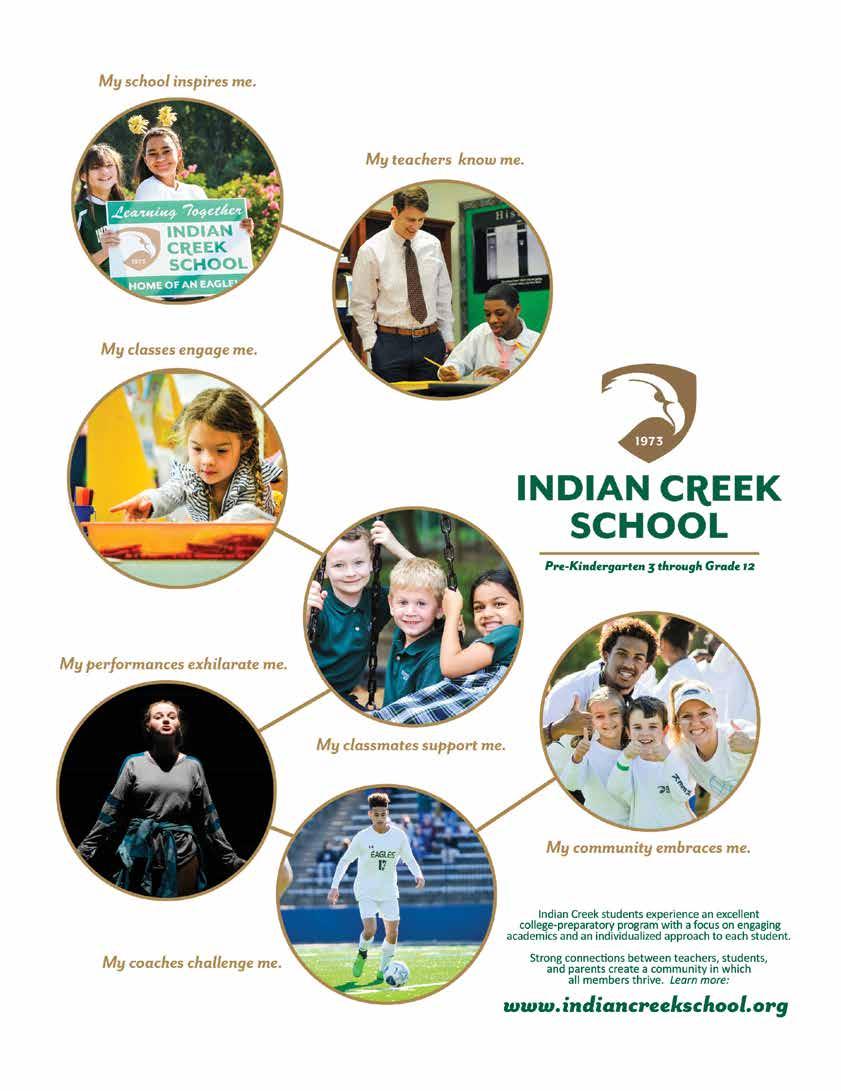
11 minute read
Educating the Next
Educating the Next Generation of Investors,
CONSUMERS, AND BORROWERS (YOUR KIDS!) BY DYLAN ROCHE
“MOM! DAD! CAN I HAVE SOME MONEY?”
Whether they’re as young as kindergarten or old enough to be preparing for college, some kids seem to think—as the saying goes—that money grows on trees.
But understanding the value of a dollar, along with responsible practices like budgeting, saving, and investing, are all lessons that begin at home, where they’re taught by parents or other adult role models. And these lessons are important because, as with other life skills, children who learn to be responsible with money when they are young tend to keep those habits as they get older.
It’s for these reasons that the Youth Financial Literacy Foundation encourages parents to teach financial literacy starting from a young age. “Financial education should be a continuous process, right from childhood to adulthood,” the organization explains. “Unfortunately, not even our learning institutions seem to recognize this fact. We tend to assume that people will somehow learn about money on their own. There needs to be a paradigm shift when it comes to financial literacy.”
Taking steps to ensure that kids are well-versed in finances will set them up to being able to build wealth, be prepared for emergencies, and stay out of debt.
“But why can’t kids just be kids?” some parents might think. Although it’s true that not every aspect of financial literacy will be appropriate for young children, even simple lessons can make a big difference in a young person’s relationship with money.
—THE NATIONAL FINANCIAL EDUCATORS COUNCIL.
It doesn’t have to be a daunting task—everything from giving your child an allowance to taking them on a trip to the bank is an opportunity for teaching them. Here’s what you should consider…
START YOUNG: LESSONS IN EARNING, SPENDING AND SAVING
While a topic like financial literacy sounds so adult-centric, it doesn’t have to be. Financial literacy simply refers to understanding how to be responsible with money. Start with age-appropriate lessons from the time children are small. Your focus in the beginning should be on understanding money and how it is exchanged. Children as young as 4 or 5 can start identifying coins and recognizing how they add up into dollars.
These early years are also an ideal time to start teaching children about making decisions around money. The younger they are when they start doing this, the faster they become more comfortable and confident with it. When you take your next trip to a toy store, point out the price tags and show how bigger or fancier toys cost more than smaller or simpler toys. These lessons in the early years lay the groundwork for the lessons that come later.
As with other life lessons, financial literacy begins with basic concepts, but children and adolescents will get the most value out of the life experiences where those concepts are applied. A parent can talk about topics like spending, budgeting, saving, investing, and credit, but these concepts are just the beginning. In its 2018 study titled A Review of Largescale Youth Financial Literacy Education Policies and Programs, the Brookings Institute explains, “Specific knowledge and skills that can be applied in a practical way to the real world emerge out of these core concepts.”
KID INCOME: A WEEKLY ALLOWANCE
Most children have their first experience with handling money in the form of an allowance. An allowance does not need to be a large sum of money to provide a proper educational experience. When determining an amount for an allowance, consider how much money you provide your children throughout the course of any given month. In some cases, you may be giving children more money in small increments than they would get through an allowance. Providing a set amount every week will allow children to make financial decisions on their own and determine which purchases are truly worthwhile.
Encourage smart money habits like budgeting and saving by showing children how to create four separate jars or envelopes where they keep their money: SPEND: the money they can use for everyday activities SHORT-TERM SAVING: the money they can use for a bigger purchase that they can’t afford with a single week’s allowance (such as a bike or a video game) LONG-TERM SAVING: the money they’re setting aside to deposit in a bank account or to invest (more on this topic soon) CHARITY OR GIVING: the money they want to give to a good cause they support Children don’t have to divide their money evenly across all four of their banks, but they should aim to deposit the same amount from week to week. Help them determine their priorities—for example, if they have a $30 allowance, they might want to put $5 in long-term savings, $2 to charity, $3 to short-term savings, and $20 to spending.

Teach them the concept of paying yourself first. They should set aside money to be saved as soon as they receive it. If they decide they will simply save whatever they don’t spend within a week, it’s easy for them to blow through all their money and then never actually save anything.
If children are running through their allowance too quickly, show them how to keep a spending diary to track where their money goes. Ask them whether each
purchase is worthwhile in the long term so they can start to prioritize where they’re spending their money. They can use this spending diary to set a budget and determine ahead of time how they’ll be spending their dollars every week.
If your kid isn’t great a budgeting right away, that’s all right—they’re not going to be as responsible in their choices as an adult might be. Remember that all lessons should be constructive.
Consider it this way: Most people who are learning to manage a budget, whether they’re a child or an adult, will often be taught some variation of the lesson that buying a specialty coffee drink every day will add up over the course of months and years. This can be frustrating because what they hear is that they’re broke because they buy coffee every day. “Educators need to keep in mind the original intent of the latte factor concept,” explains the High School Financial Planning Program, a subset of the National Endowment for Financial Education. “The lesson is meant to be an educational tool to empower students, not to shame them. Understanding how small expenses can add up to real savings over time encourages students to make mindful daily decisions and to see that that many of their financial goals are within their control. Learning how small amounts add up is more impactful when viewed through the lens of how that money saved can be used toward a goal that they value.”
BEYOND THE PIGGY—PUTTING MONEY IN A REAL BANK

When a child is ready to get serious about saving, the next step is to open a custodial account, a type of bank account held by a parent or legal guardian in their child’s name. The adult legally controls the account until the minor comes of age, at which point they gain full control of it. Once a child has more than $200 saved at home, it only makes sense to put that money in the bank, as this will ensure the money is safe and will let your child collect interest, the first of many savings and investing terms your child will learn throughout the process. Explain to your child that they are technically lending their money to the bank by making a deposit; therefore, the bank is paying them a small percentage every month as long as that money stays in their account. In the meantime, the bank might provide loans to other borrowers who are in turn charged interest as they pay off their debt. People might take out loans from a bank for any number of reasons, such as to buy a home or to start a business—and all that money they borrow comes from people who are keeping their money in the bank. Things like interest rates (for either borrowing or saving), as well as added fees (such as overdraft fees), help people determine which bank they use.
Another way of borrowing money is the use of credit cards, which some parents
might choose to give their child to cover certain expenses. However, if you are introducing your child to credit, be sure they understand that what they buy on credit is not free money. Buying on credit, like taking out a loan, puts a borrower in debt, which they must pay back to the bank in consistent monthly increments (plus interest). The sooner they pay the money back, they less money they end up owing in the long term because they are paying back less interest.
MAKING INVESTMENTS UNDERSTANDABLE FOR YOUTH
Beyond saving their money in a bank account, the other way youth can become financially literate individuals is by making investments—another means of putting your money toward something with the expectation that you’ll get even more money back in return. A savings account is a type of investment that carries little risk (in other words, you know your original investment is protected, and you can access it whenever you want to). On the other hand, it doesn’t offer opportunity for growth above and beyond the interest you collect.
With other types of investments, there’s potential for greater growth; the drawback is that there’s also risk of losing money. The two most common types of investments are:
STOCKS: When an investor buys a share of stock, what they are doing is purchasing what’s known as a share of that company—if the company makes money, they receive a part of the profits. But if the company does poorly, then the price of that stock will go down and the shareholder loses money on their investment.
Stocks are considered a long-term investment that a person holds for a decade or more, during which time the price of the stock could go up and down. Despite these daily fluctuations, a stock will ideally be worth more in 20 years’ time than it was when it was first purchased; however, this isn’t always the case. Many shareholders pay close attention to stock fluctuations on the internet every day.
BONDS: These are issued by the government or by corporations to borrow money for certain projects. A government bond could help fund infrastructure or education endeavors, whereas a corporate bond might cover new property or employment expansion.
Bondholders can keep the bond until it reaches maturity—the point at which the borrower must pay it off—or the bond can be sold to other investors. In most cases, bonds are a safe investment, but they aren’t completely free of risk. If interest rates change significantly, it could change the value of the bond. Additionally, as with any situations of borrowing and lending, the body that issued the bond might be unable to pay back the debt (this is known as defaulting on a loan).
Although minors can’t buy stocks or bonds, parents can do this on their behalf via a custodial account. Consider investing only money that children and teens have earned themselves through their allowance or an af-
—THE NATIONAL ENDOWMENT FOR FINANCIAL EDUCATION
ter-school job—this way, they have a better appreciation of the risk and reward involved.
Before you make any investments, be sure to explain to your child the importance of diversification, i.e. keeping a varied range of investments. Diversification lessens the risk involved and saves you from losing too much when one of your investments turns out to be unsuccessful. For example, if something goes wrong with stock they hold, they still have their other stocks, as well as their bonds and savings account.
The important takeaway about investing is that children understand it’s about putting your money toward something that will increase in value—and in an ideal situation, an investor gets more money back than they put in.
The National Endowment for Financial Education explains this concept in its online resource Your Spending, Your Savings, Your Future: A Beginner’s Guide to Financial Readiness by stating, “There can be confusion about the words saving and investing. For example, someone might claim that a new car is an investment, which probably is not true since most cars lose their value over time and an investment ideally should increase in value. Think of saving and investing as methods of setting aside money for the future. The best method depends on your needs and goals.”
WHERE TO GO FOR MORE INFO
Financial literacy is a complicated topic and is something that requires lifelong learning. For families that want more guidance on how to broach these topics with children of any ages, a great resource is the Council for Economic Education (www. councilforeconed.org), which provides lessons and tools for teaching kindergarteners through high school seniors. Teens who are interested in growing as investors should check out the Young Investors Society (www. yis.org), which supports extracurricular programs at schools and offers online resources to help students learn more about making their money work for them.











